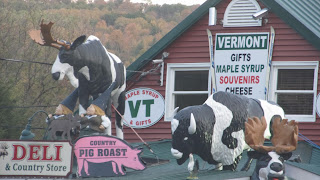 |
| A deli in the town of Hoosick, New York |
 The Morgan Horse is the state animal symbol of Vermont.
The Morgan Horse is the state animal symbol of Vermont.Coulda fooled me. I surely would have thought it’d be the moose given all the road signs and other moose hoopla (Moosefest!).
And now, with the tremendous and delightful Catamount Prowl street art deal, put on by the Bennington Chamber of Commerce, why isn’t the state animal this gorgeous, inspiring beast?
 |
| From the Blue Cat Group |
But there are no actual catamounts left in Vermont besides those beautiful, fun, fiberglass ones along the streets of Bennington.
 |
| The Kiss |
From a post at WCAX.com -- 'Are Catamounts Really Extinct?'
"If we had a breeding population here in Vermont we would know it, we would have evidence of that," Blodgett said. "That they readily leave behind tracks and scat, kill remains, those type of things, even though we have been looking, we can't come up with those things here in Vermont."
 A catamount by any other name is a:
A catamount by any other name is a:Cougar
Panther
Mountain Lion
Puma
How did the catamounts get gone from Vermont?
In the wild, catamounts ate deer and other animals. But in the 1800s, farmers had cut down many trees and turned forests into farms. Without the trees, there were not as many deer as before. The catamounts started eating sheep that lived on farms. The farmers and hunters killed the panthers to protect their sheep.Humans reduced and/or eliminated the cat's home and were quick to shoot first and find alternate solutions never. These magnificent beasties are gone.
 Meanwhile out in the wild, wild west (from the Cougar Fund's timeline):
Meanwhile out in the wild, wild west (from the Cougar Fund's timeline):In 2003 South Dakota removes cougars from state threatened list and reclassifies as a game animal.Disgusting.
In 2004 South Dakota holds first cougar hunting season.
In 2007 North Dakota expanded hunting season to include 2 zones, one of which has no restrictions on how many can be killed.
According to Wikipedia, there’s a very small population in Florida still:
The most recent documented count for the Florida sub-population is 87 individuals, reported by recovery agencies in 2003.[113] In March 2011, the USFWS declared the Eastern cougar extinct. However, with the taxonomic uncertainty about its existence as a subspecies as well as the possibility of eastward migration of cougars from the western range, the subject remains open.The sitch doesn’t look good and. boyhowdy, that gives me a big-ass sad and, yes, that IS an understatement..
I’m truly hoping that the Catamount Prowl street art exhibit gets folks thinking beyond the symbol, beyond the funny/cute/hip/dreamy/beautifully painted sculptures.
An encouraging blog post from the Cougar Rewilding Foundation blog -- Cougars Cutting it in Santa Cruz
 |
| I believe they're related -- you can see the resemblance, right? |
To facilitate the recovery of the cougar in suitable wild habitat east of the Rocky Mountains.And here's The Cougar Fund's mission satement:
1. Promote recovery of breeding populations of cougars through natural recolonization and mandated restorations to the central, southeastern and eastern United States, advocating responsible management in habitat where cougars are recovering.
2. Promote full legal protection of all cougars living wild east of the Rockies, regardless of origin.
3. Conduct public education programs by preparing cougar education modules and lesson plans, exhibiting at outdoor and conservation events, and giving presentations to interested groups.
4. Conduct habitat and public attitude surveys.
5. Evaluate evidence and conduct investigations in collaboration with wildlife agencies to document cougar presence along their expanding range into eastern habitat.
The Cougar Fund protects the cougar--also known as a mountain lion, puma, and panther--and other carnivores throughout the Americas by educating children and adults on their value, by funding and promoting the use of sound science, and by monitoring state policies to assure a lasting place for these creatures.These are just two groups -- there must be more.
No comments:
Post a Comment